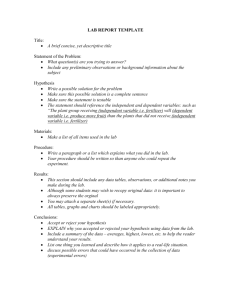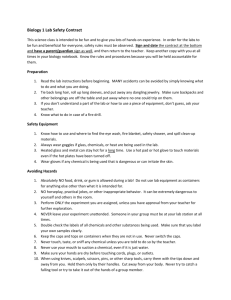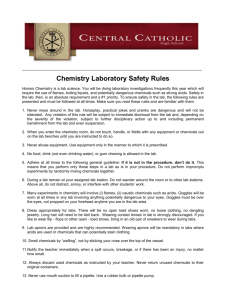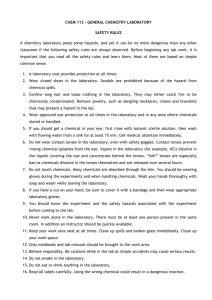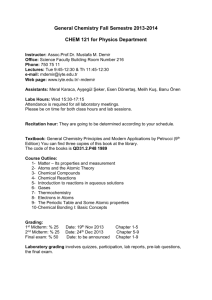Introduction to Physical Science
advertisement
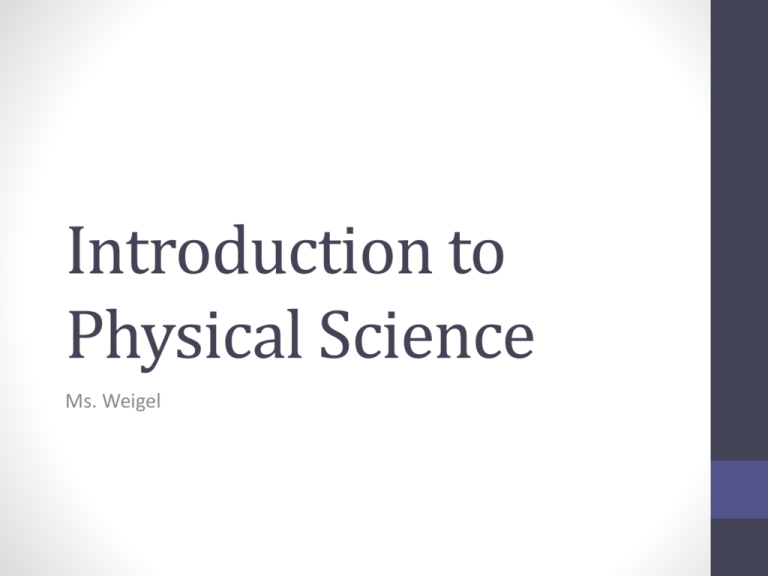
Introduction to Physical Science Ms. Weigel SECTION ONE What is physical science? • Physical science is the scientific study of nonliving matter • In this unit you will: • Learn about how scientific progress is made • How scientists conduct investigations • How to use a variety of tools to collect, analyze and understand results Nature of Science • Physical science is divided into physical science, earth science and life science. • Primary parts of physical science are chemistry and physics. Review • What are some careers that involve science? • Doctor, chemist, biologist • Who are scientists that you know of? • Einstein, Mendel, Newton • What are some different aspects you can learn in science? • Chemistry, astronomy, plants Discussion • What do you usually do when you have questions? Investigation: The search for answers • After you as a question its time to find the answer. • There are several methods you can use to start your investigation: 1. 2. 3. Research Observation Experimentation Research • Look up information in books, internet or other sources. • You can find out info by reading past experiments. • Make sure to always use reliable sources Observation • You can find answers by making careful observations. • Observations could be hourly, daily, weekly • You will find associations form day to day Experimentation • You can answer your own questions by doing experiments. • Create hypothesis, which is a trial explanation, to test • Research, observation and extermination all go together to find your answers Applying Answers • Although people cannot use science to answer every question, there are some interesting answers to be found. • Science affects you and everything around you. Saving lives • Using sciences people have found answers to many questions. • How can people be protected in car accidents? • Seat belts, strong made cars, air bags Saving Resources • How can we make resources last longer? • Recycling is one answer • Using science people have developed more efficient methods for recycling steel, aluminum, paper, glass and even some plastics. Protecting the environment • How can the ozone layer be protected? • Aerosols damage the ozone layer • Why does the loss of this layer matter? • UV rays, skin cancer • By finding ways to reduce chemicals we can protect the environments and make the world healthier Scientists are everywhere • Meteorologist • Study the atmosphere • Geochemist • Chemistry of rocks and minerals • Ecologist • Behavior of living things • Volcanologist • Study lava and volcanos • Science Illustrator • Career using art and science Assessment • What are are three methods of investigation? • Research, observation and experimentation • Your friend wants to know the amount of salt added to her favorite fast food French fries. What would you recommend that she do to find out the amount of salt? • Scientific investigation Homework • Write one paragraph about a job that relates to science Scientific Method SECTION TWO What are scientific methods • Scientific methods- ways in which scientist answer questions and solve problems. Asking a question • Observation- any use of the senses to gather information • Examples: • Noting the sky is blue, or a cotton ball is soft • Measusrements are observations that are made with tools • Observations made should be accurately recorded Forming a hypothesis • Hypothesis- is a possible explanation or answer to a questions • Good hypothesis are testable. • Information can be gathered and experiments can be designed • Making predictions • Before scientists test the hypothesis, they make predictions about what will happen Testing the hypothesis • After you form a hypothesis you need to test it • Controlled experiments • Compares the results from a control group with the results of an experiment group (variables) • Control group- are factors kept the same and do not change • Variable- factors that can change • Data- any pieces of information gotten through expermination Analyzing the results • After you collect your date, you need to analyze it • Organize data into tables or graphs to make relationships between information easier to see Drawing Conclusions • At the end of the investigation you must draw a conclusion • You may find • Your conclusion supports your hypothesis • Your conclusion does not support your hypothesis • IF so you can change the procedure, gather more information or ask new questions Communicating Results • Write a scientific paper • Making a presentation • Creating a Website • Other scientists can then conduct their own test based on your results Scientific Method Lab • M& M Activity Review • Section 2 review • Answer questions #1-6 • Challenge questions #11 Safety in science SECTION 3 It’s better to be safe, then sorry • Things that are crucial to science: • Exploring, inventing and investigating • Don’t take chances with your own safety or anyone else's Safety Symbols • Books and worksheets will contain safety symbols to let you know about concerns. • Becoming familiar will let you know about dangers in the laboratory Symbols of knowledge Eye Safety • Wear goggles when working around chemicals, acids, baes or flame. • Wear safety goggles anytime there is a chance that your eyes could be harmed. • If anything gets in your eyes, notify the teacher immediately and flush your eyes with running water for 15 minutes Safety Equipment • Know the locations of: • Fire alarms • Fire blankets • Eyewash fountains Neatness • • • • • • Keep your work area free of all unnecessary books and papers. Keep hair back and secure loose sleeves Remove jewelry No open-toed shoes in the lab Never eat or drink in the lab Avoid flammable hair products Sharp/pointed Objects • Use knives and instruments with extreme care • Place objects on work surface for cutting Heat • • • • Wear safety glasses when using heat When possible use a hot plate for heat When heating test tubes angle away from your body To avoid burns, wear heat resistant gloves Electricity • Be careful with electrical cords • Do not used equipment with damaged cords • Make sure electrical equipment is in the off positon when finished Chemicals • Wear safety goggles • If a spill gets on your skin or clothing rinse immediately for at least 5 minutes • Never mix chemicals unless instructed to • Never taste, touch or smell chemicals Animal Safety • Always obtain permission before bringing any animal into the building • Handle animals only as directed • Wash your hands after handling. Plant Safety • Do not eat plant parts used in lab • Wash hands after handling • Do not pick wild plants you do not know Glassware • Examine before use • Clean and free of chips and cracks • Report damage Safety Contract • PREPARE FOR LABORATORY WORK · Study laboratory procedures prior to lesson/labs. · Never perform unauthorized experiments. · Keep your lab table organized and free of apparel, books, and other clutter. · Know how to use the safety shower, eye wash, fire blanket and first aid kit.(I will show you.) DRESS FOR LABORATORY WORK · Tie back long hair especially bangs. · Do not wear loose sleeves as they tend to get in the way. · Wear shoes with tops. No flip flops on lab days. · Wear lab aprons during all laboratory sessions. · Wear safety goggles during all laboratory sessions. · Wear gloves when using chemicals that irritate or can be absorbed through skin. • AVOID CONTACT WITH CHEMICALS · Never taste or "sniff" chemicals. · Never draw materials in a pipette with your mouth. · When heating substances in a test tube, point the mouth away from people. · Never carry dangerous chemicals or hot equipment near other people. AVOID HAZARDS · Keep combustibles away from open flames. · Use caution when handling hot glassware. · When diluting acid, always add acid slowly to water. Never add water to acid. · Use glycerin and twist slowly at the base when inserting glass-tubing throughstoppers. · Turn off burners when not in use. · Do not bend or cut glass unless appropriately instructed by teacher. · Keep caps on bottles. Never switch caps with one from another bottle. • CLEAN UP · Consult teacher for proper disposal of chemicals. · Wash hands thoroughly following experiments. · Leave laboratory tables clean, neat and set-up for the next class. All supplies will go back in their proper place. IN CASE OF ACCIDENT · Report all accidents and spills immediately. · Do not touch broken glass. It will be cleaned by the teacher. · Wash all acids and bases from your skin immediately with plenty of running water. · If chemicals get in your eyes, wash them for at least 15 minutes with in eyewash station. Only use the eye wash station and shower in an emergency with teacher’s permission. Safety Rap • https://youtu.be/XYbOSmYme6Y Review • Have lab safety contract signed • Lab safety- “what is wrong” worksheet
